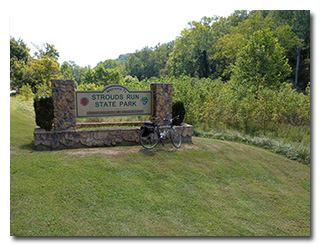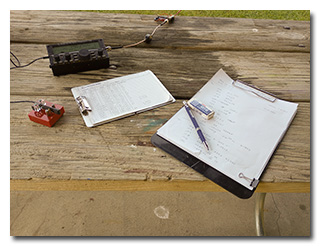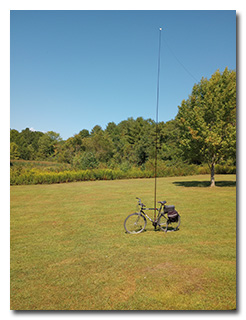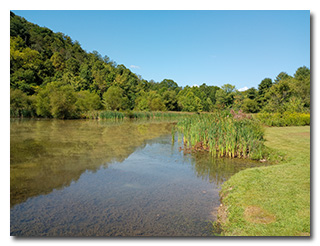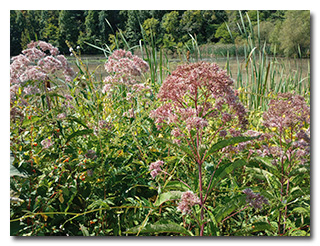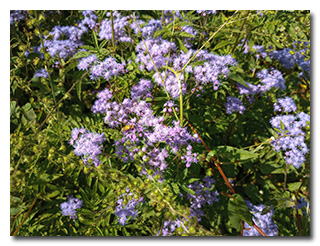
by William Eric McFadden
From the Strouds Run State Park website:
-
Strouds Run State Park is located in the scenic forested hills of Athens County, in the midst of the unglaciated Appalachian Plateau. Although untouched by the vast ice sheets that moved across portions of the state over 12,000 years ago, Strouds Run displays the effects of the glaciers -- in the deep ravines and high hills -- where the valleys served as outlets for torrents of glacial meltwaters. The erosive power of these waters carved the valleys and hillsides, creating the familiar topography Ohioans know today. Large deposits of glacial outwash, primarily sand and gravel, were deposited along these streams and strongly affected the type of biological communities present today.
Sandstone, the principal bedrock outcropping in the region, is very resistant to erosion and forms the uplands and steep sides of the valleys. Twisting roads and forest trails pass through these deep ravines and lead to dense stands of beech, hickory, oak, maple and tuliptree. Seasonal displays are offered by flowering dogwood, redbud and spring wildflowers -- with fall presenting a pageant of colorful foliage. These woods are home to white-tailed deer, fox, raccoon, opossum, squirrel, wild turkey and a variety of songbirds. Woodthrush, white-breasted nuthatch, scarlet tanager, pileated woodpecker and the rufous-sided towhee inhabit the forest canopy. These rugged hills and woodlands are truly reminiscent of the wilderness that characterized the Ohio country in the days of early settlers.
Pictures
- The Strouds Run State Park sign
- Eric's station
- The mast and antenna supported on Eric's bicycle
- Dow Lake
- Flowers on the lakeshore: 1 | 2
Description
On Labor Day 2023 (September 4, 2023), one member of the Southeast Ohio Radio Adventure Team performed a successful bicycle-portable activation of Strouds Run State Park (K-1994) as part of the Parks on the Air (POTA; link) program.
Starting his ride early to beat the heat, Eric McFadden, WD8RIF, bicycled from his home to Strouds Run State Park with his small and lightweight KX2 Mini Travel Kit. Eric began his ride at 1343 UTC, arriving at Bulldog Shelter in Strouds Run State Park at 1434 UTC, and was pleased to find the picnic shelter to be entirely unoccupied. A highlight of the ride was seeing one half of the nesting pair of osprey as he bicycled across the Hocking River on Stimson Avenue.
Eric set up his Elecraft KX2 transceiver on an available picnic table, bungied his Goture Red Fox Super Hard 720 carbon-fiber mast vertically to his bicycle, sloped the Tufteln (link) 35' EFRW antenna from the KX2 up to top of the mast, and deployed three 17' counterpoise wires directly on the ground. Eric was on the air at 1445 UTC.
As at nearly all of his previous operations at this location, Eric had good cell-signal and would be able to spot himself on the POTA Spots website and to use POTA Spots to identify possible Park-to-Park (P2P) QSOs.
Noticing that most POTA activators were being spotted on 14 Mhz and higher frequencies, Eric decided to start on 20m. After finding a clear frequency, he began calling "CQ POTA" and was quickly auto-spotted to POTA Spots. His first QSO came at 1450 UTC with AC4FS in Florida. QSOs came steadily, with Eric's twelfth QSO coming at 1504 UTC with WA5EEZ in Oklahoma. This run included QSOs with operators located in Florida (3), Missouri, Arkansas, Maine, Georgia, Texas (2), Louisiana, Minnesota, and Oklahoma.
After the run on 20m ended, Eric checked POTA Spots for P2P QSO opportunities. At 1504 UTC, he made a P2P QSO on 20m with WS4Y at Fred Gannon Rocky Bayou State Park (K-1873) in Florida, and at 1513 UTC he made a P2P QSO on 40m with KB8PGW at Manistee National Forest (K-4583) in Michigan.
Finding a clear frequency on 40m to run, Eric began calling "CQ POTA" and was quickly auto-spotted to POTA Spots. His first QSO in this run came at 1517 UTC with KB9BVN who was activating Morgan-Monroe State Forest (K-4215) in Indiana. QSOs came quickly, with Eric's fifteenth QSO in this run coming at 1531 UTC with NI8N in Ohio. This run included a two-fer P2P QSO with K3RTA who was activating White Clay Creek National Wild and Scenic River (K-08989) and Lums Pond State Park (K-1741) in Delaware; a P2P QSO with KN3A who was activating Captain John Smith Chesapeake National Historic Trail (K-4567) in Pennsylvania; and QSOs with operators located in Indiana (2), Ohio (3), Delaware (2), Pennsylvania (2), Michigan (4), Illinois, and Wisconsin. The QSO with WB9CYY in Wisconsin was special because Don was running a Heathkit HW-8 at 1.7-watts output. His HW-8's transmitted note had a delightful little chirp. (See Don's article on HW-8 mods, linked on Eric's Heathkit HW-8 page.)
In all, Eric logged twenty-nine QSOs, with six P2P QSOs, in forty-six minutes of on-air time. All of Eric's QSOs were CW and were made at five watts output.
As at his other recent bicycle-portable activations of Strouds Run State Park, the KX2 and the Tufteln 35' EFRW antenna performed very well.
Eric took some photos, tore down his station, loaded his bicycle, and began his ride home, making a short detour to the Bobcat Shelter to verify that commercial power was available for next weekend's Ohio State Parks on the Air (link) with the Athens County Amateur Radio Association (link).
Eric also submitted his log to the World Wide Flora and Fauna in Amateur Radio (WWFF; link) program for an activation of Strouds Run State Park, KFF-1994.
(return)
